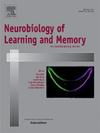Synergistic impact of early-life stress and prenatal immune activation on spatial memory and oxidative metabolism in rat cortico-limbic networks
IF 1.8
4区 心理学
Q3 BEHAVIORAL SCIENCES
引用次数: 0
Abstract
Early life exposure to immune activation and stress are critical factors involved in the development of mental and neurodevelopmental disorders in adulthood. This study explored the individual and combined effects of prenatal lipopolysaccharide-induced (LPS)-induced immune activation and postnatal maternal separation on cognitive performance and oxidative metabolism in male Wistar rats. Using a 2 × 2 factorial design, pregnant dams were exposed to LPS or saline on gestational day 15, and offspring underwent maternal separation from postnatal days 2–14. In adulthood, cognitive function was assessed using the Morris Water Maze, and regional brain energy metabolism was evaluated using quantitative histochemistry of cytochrome c oxidase (CCO) quantitative histochemistry in the prefrontal cortex, hippocampus, and retrosplenial cortex.
Rats exposed to both stressors demonstrated significant impairments in spatial memory and cognitive flexibility, supporting the “two-hit” hypothesis of early adversity, which posits that early life exposure to an adverse environmental event (first hit) combined with subsequent exposure to stress during critical developmental periods (second hit) can significantly increase the risk of developing behavioral or neurodevelopmental disorders in adulthood. Accordingly, adult animals exposed to prenatal LPS and maternal separation showed prolonged escape latencies and decreased spatial memory retention during the behavioral tasks. Concurrently, CCO activity was markedly increased in all measured regions, reflecting heightened metabolic demands. These changes are consistent with impaired hippocampal-prefrontal-retrosplenial network integration and the underlying key processes involved in cognitive alterations such as memory or attention.
This study underscores the synergistic effects of these environmental factors on cognitive and metabolic dysfunction, providing a translational model to better understand the etiology of neurodevelopmental disorders. The findings highlight the importance of addressing multiple interacting environmental factors in the context of early life adversity.
早期应激和产前免疫激活对大鼠皮质边缘网络空间记忆和氧化代谢的协同影响
早期生活暴露于免疫激活和压力是成年期精神和神经发育障碍发展的关键因素。本研究探讨了产前脂多糖诱导的免疫激活和产后母体分离对雄性Wistar大鼠认知能力和氧化代谢的单独和联合影响。采用2 × 2因子设计,孕鼠在妊娠第15天暴露于LPS或生理盐水中,后代在出生后2 - 14天与母亲分离。在成年期,使用Morris水迷宫评估认知功能,并使用细胞色素c氧化酶(CCO)定量组织化学评估前额叶皮层、海马和脾后皮层的区域脑能量代谢。暴露于这两种压力源的大鼠在空间记忆和认知灵活性方面表现出明显的损伤,这支持了早期逆境的“两次打击”假说,该假说认为,早期生活中暴露于不利环境事件(第一次打击),再加上随后在关键发育时期暴露于压力(第二次打击),会显著增加成年后发生行为或神经发育障碍的风险。因此,暴露于产前LPS和母亲分离的成年动物在行为任务中表现出较长的逃避潜伏期和较低的空间记忆保留。同时,CCO活性在所有测量区域显著增加,反映了代谢需求的增加。这些变化与海马-前额叶-脾后网络整合受损以及涉及认知改变(如记忆或注意力)的潜在关键过程一致。这项研究强调了这些环境因素对认知和代谢功能障碍的协同作用,为更好地理解神经发育障碍的病因提供了一个翻译模型。研究结果强调了在早期生活逆境的背景下解决多种相互作用的环境因素的重要性。
本文章由计算机程序翻译,如有差异,请以英文原文为准。
求助全文
约1分钟内获得全文
求助全文
来源期刊
CiteScore
5.10
自引率
7.40%
发文量
77
审稿时长
12.6 weeks
期刊介绍:
Neurobiology of Learning and Memory publishes articles examining the neurobiological mechanisms underlying learning and memory at all levels of analysis ranging from molecular biology to synaptic and neural plasticity and behavior. We are especially interested in manuscripts that examine the neural circuits and molecular mechanisms underlying learning, memory and plasticity in both experimental animals and human subjects.

 求助内容:
求助内容: 应助结果提醒方式:
应助结果提醒方式:


